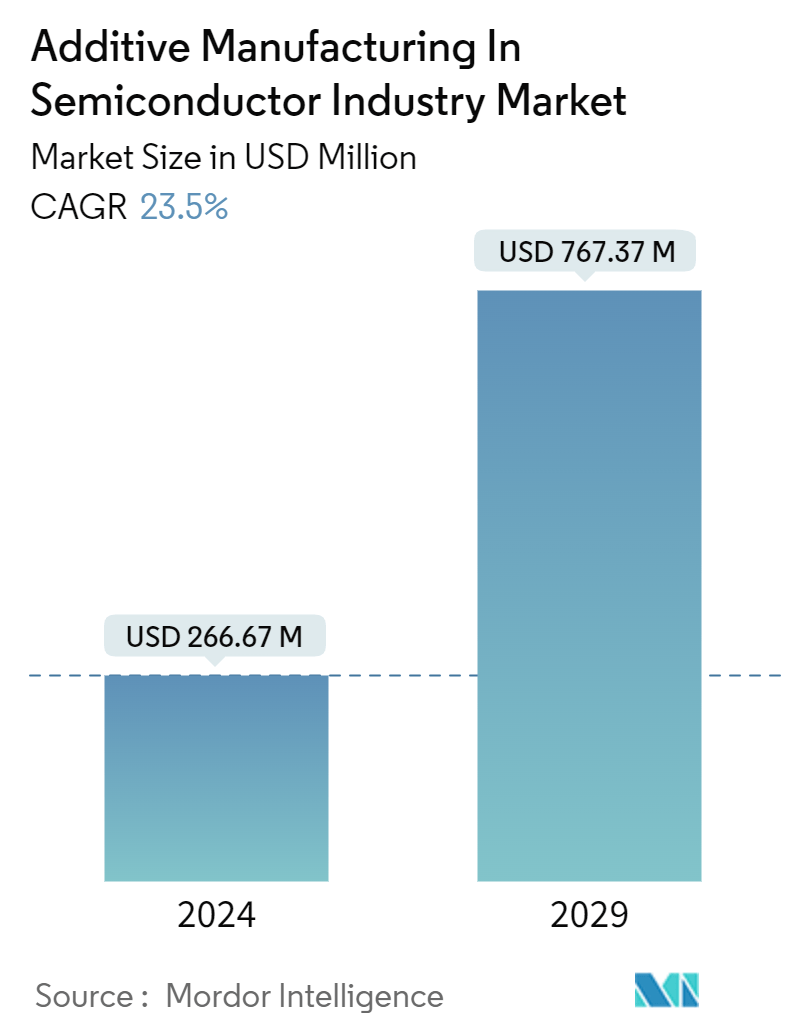Market Size of Additive Manufacturing In Semiconductor Industry

| Study Period | 2019 - 2029 |
| Market Size (2024) | USD 266.67 Million |
| Market Size (2029) | USD 767.37 Million |
| CAGR (2024 - 2029) | 23.50 % |
| Fastest Growing Market | North America |
| Largest Market | Asia Pacific |
| Market Concentration | Low |
Major Players*Disclaimer: Major Players sorted in no particular order |
Additive Manufacturing In Semiconductor Market Analysis
The Additive Manufacturing In Semiconductor Industry Market size is estimated at USD 266.67 million in 2024, and is expected to reach USD 767.37 million by 2029, growing at a CAGR of 23.5% during the forecast period (2024-2029).
- The potential for additive manufacturing within the semiconductor sector appears highly encouraging. With ongoing technological advancements and decreasing costs, adoption is anticipated to become more widespread. Developments in materials and processing methods are expected to enhance the versatility of additive manufacturing in the semiconductor industry, facilitating the creation of intricate and precise semiconductor parts.
- The demand for semiconductors is experiencing a significant surge as an increasing number of products rely on them for operation. This demand is primarily fueled by the production of consumer electronics, including smartphones, tablets, and desktop computers, as well as industrial and military devices such as sensors, microchips, and lasers. In order to meet this growing demand, semiconductor manufacturers require new capital equipment to sustain and enhance their silicon processing capabilities.
- The semiconductor manufacturing landscape is experiencing significant transformation as technological advancements strive to address industry demands. The implementation of process automation enhances efficiency and minimizes defects within the production workflow.
- Consequently, there is an increasing focus on additive manufacturing in semiconductor fabrication. Through 3D printing, components are produced layer by layer, utilizing computer-aided design (CAD) files to achieve intricate geometric configurations. Additive manufacturing is revolutionizing the methods of wafer processing and lithography.
- As the emphasis on sustainability intensifies, the minimized material waste and energy efficiency associated with additive manufacturing will be vital to the industry's sustained expansion. Overall, additive manufacturing is set to emerge as a fundamental element in semiconductor production, fostering innovation and enhancing efficiency in the foreseeable future.
- The rising government initiative and investment to boost the semiconductor industry are expected to propel market growth. For instance, in July 2024, the Canadian government declared a CAD 120 million (USD 88.56 million) investment in a semiconductor initiative exceeding CAD 220 million (USD 162.36 million), known as FABrICm, which is spearheaded by CMC Microsystems (CMC). As a not-for-profit research organization, CMC is expected to facilitate the establishment of the Fabrication of Integrated Components for the Internet's Edge (FABrIC) network, collaborating with its partners in Canada.
- Nevertheless, the expenses associated with additive manufacturing remain elevated, resulting in challenges related to affordability, particularly in developing and underdeveloped nations. More qualified personnel are needed to operate this equipment. These elements have hindered the expansion of the market.
- The semiconductor sector has experienced slight month-to-month growth; however, it is confronted with various challenges, including rising prices, geopolitical conflicts, and the ongoing effects of the pandemic. These elements influence consumer behavior and add to macroeconomic instability, resulting in variations in semiconductor demand, which can further affect market growth. In addition, the industry is impacted by currency fluctuations and the potential threat of a global economic recession.

